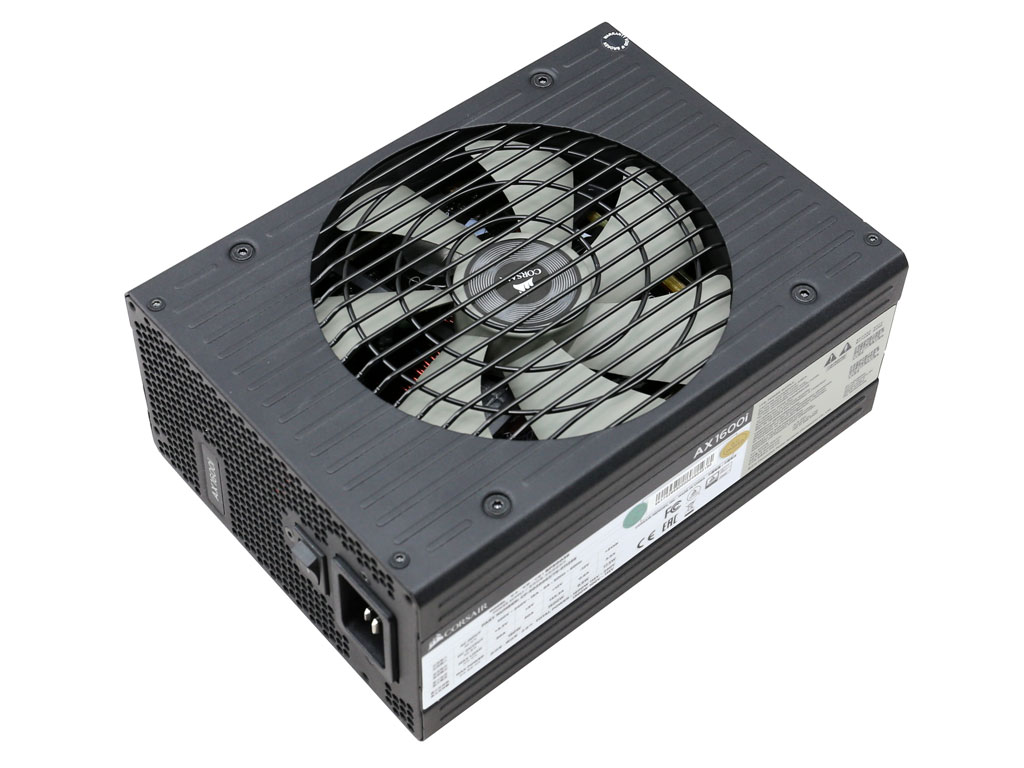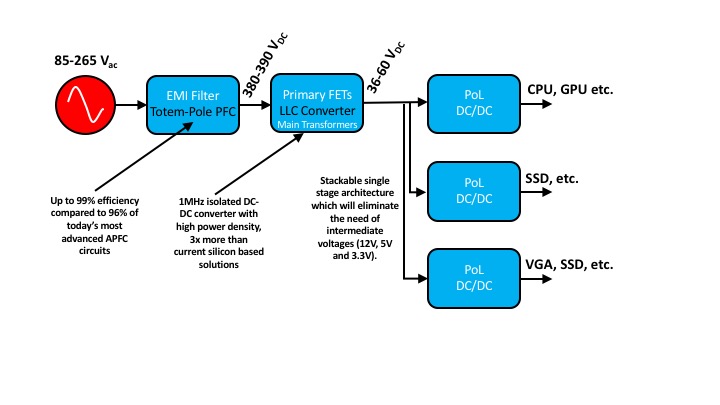Tom's Hardware Verdict
The Corsair AX1600i is the best PSU that money can buy today, period. It offers top performance on all areas and it uses an innovative platform, which provides us a glimpse at the future of power supply design.
Pros
- +
Full power at 48°C
- +
Powerful
- +
Efficient
- +
Ripple suppression
- +
Load regulation
- +
Hold-up time
- +
Accurate Power Ok signal
- +
Inrush current
- +
Silent
- +
Quality caps
- +
Fully modular
- +
Amount of connectors
- +
Quality fan
- +
Corsair Link app
- +
Magnetic side covers
- +
Warranty
Cons
- -
Expensive
- -
Small distance between peripheral connectors
- -
EMI with AVG detector
Why you can trust Tom's Hardware
Features & Specifications
We've been wondering when a power supply manufacturer would come up with a product able to match the performance of Corsair's AX1500i. Now more than three years old, the AX1500i remains unrivaled in our benchmark results thanks to its advanced digital platform.
The company loves a challenge, though. Not willing to wait for the competition to catch up, Corsair is ready to extend its advantage even further. If you ask us, it's strange to spend time and money on a new PSU when the existing one is already class-leading. But Corsair apparently wants to show everyone that it has the know-how and necessary partners to rock this industry at will.
Enter the AX1600i. We're naturally expecting great things from this model, given what we measured from the AX1500i. Currently, the best 1600W PSU is EVGA's 1600 T2, and it's based on an analog Super Flower platform. So of course we're anxious to see how that holds up to an all-digital architecture.
The 80 PLUS program starts looking obsolete in the context of advanced PSUs like this one. Even the organization's highest rating (Titanium) cannot fully describe the potential of modern digital platforms. For now, they're lumped into the same category as older ones. Thankfully, Cybenetics' ETA efficiency standard has a higher level (ETA-A++) that the AX1600i cannot reach. In three or four years, we think we'll start seeing PSUs capable of hitting that level's requirements. It'll take fully digital converters on every rail though, including 5VSB.
Corsair's big milestone with the AX1600i is switching from silicon to gallium nitride FETs. Due to their extremely low gate charge and output capacitance, GaN FETs can be switched at extremely high speeds with reduced switching losses and improved efficiency compared to silicon ones. Moreover, GaN FETs offer up to 40% more power density than their silicon counterparts, and their faster switching speeds help minimize the dimensions of other components, especially transformers.
This diagram illustrates a typical PSU's major blocks. As you can see, there is a power factor correction stage that optimizes power grid efficiency. The PFC circuit operates as a boost converter, providing a DC output voltage close to 380V. This voltage needs to be stepped down, of course, to provide a DC bus supply that the system can utilize. A number of topologies are viable for this stage, but inductor-inductor-capacitor (LLC) and phase-shifted full-/half-bridge are commonly used to generate a bus voltage of 12V. Afterwards, the 12V rail is routed throughout the system, undergoing multiple conversion steps to power CPUs, GPUs, memory, storage, and more.
GaN introduces some major differences compared to a SI-based solution, illustrated in the diagram above. The PSU's architecture and density change due to the special features of GaN components.
Get Tom's Hardware's best news and in-depth reviews, straight to your inbox.
- PFC: By enabling a totem-pole topology, GaN devices reduce the number of active power switches (FETs) and filtering inductors by 50%. Moreover, a significant increase in switching frequency, which can reach up to 10x, significantly reduces the size of magnetics while improving overall efficiency to over 99% (versus 96% for today’s Titanium-class power supplies).
- LLC Resonant Converter: The DC/DC stage takes advantage of GaN’s superior switching characteristics to push the resonant converter switching frequencies to over 1 MHz. A higher frequency reduces transformer size, while improving power density and efficiency.
- Point of Load (PoL) DC/DC: GaN has a major impact on those converters. First, it enables a single step conversion from 36-60V in order to power your hardware, reducing the number of components needed and enabling smaller PSUs. Additionally, the smaller footprint of a GaN-based solution allows designers to easily stack the power stages for different load demands and place them close to the load for better/faster transient performance. This means that there is no need for multiple rail outputs (12V, 5V, and 3.3V), which currently impose a two-step conversion. From a single voltage output, the individual components are able to generate all required voltages. Nowadays, most components have their own DC-DC converters. But they don't all use the same voltage. With GaN-based solutions, those components can generate the needed rails from a single, higher voltage rail without increased losses, all while using fewer components in a more compact chassis.
It is easy to foresee that GaN-based solutions and digital circuits are the future of PSUs. Thanks to the new topologies emerging and their higher capacities, we might soon see a PSU with over 94% efficiency (115V) throughout its operational range. Such a product would satisfy the Cybenetics ETA-A++ requirements. If you want to dive deeper into GaN, you will find more info here and here.
Specifications
Besides 80 PLUS Titanium and ETA-A+ efficiency certifications, Corsair's AX1600i also carries a LAMBDA-A badge for its low noise output. The suite of protection features is comprehensive, and you're able to disable/enable the semi-passive fan mode. Plus, it's possible to pick between three fan profiles or set a fixed rotational speed through the bundled Corsair Link software.
Despite what GaN FETs enable, this model's dimensions are typical of what you'd expect from a 1.6kW PSU. A 10-year warranty is impressive, though. Currently, only Seasonic dares to offer an even longer warranty on its Prime family. Finally, the 450 bucks price is intimidating, that's for sure, but this is the best performing PSU and its cutting-edge platform has a high production cost.
Power Specifications
| Rail | 3.3V | 5V | 12V | 5VSB | -12V | |
|---|---|---|---|---|---|---|
| Max. Power | Amps | 30 | 30 | 133.3 | 3.5 | 0.8 |
| Watts | 180 | 1600 | 17.5 | 9.6 | ||
| Total Max. Power (W) | 1600 |
The minor rails are overkill, reminding us of a previous era when most system components relied on 5V instead of the 12V rail.
Speaking of the 12V rail, it offers monstrous capacity, delivering up to 1600W or 133.3A of current. We did expect a more capable 5VSB rail, though 3.5A should be enough in most cases.
Cables & Connectors
| Modular Cables | ||||
|---|---|---|---|---|
| Description | Cable Count | Connector Count (Total) | Gauge | In-Cable Capacitors |
| ATX connector 20+4 pin (600mm) | 1 | 1 | 16-22AWG | Yes |
| 4+4 pin EPS12V (650mm) | 2 | 2 | 16AWG | Yes |
| 6+2 pin PCIe (650mm) | 6 | 6 | 16-18AWG | Yes |
| 6+2 pin PCIe (680mm+100mm) | 2 | 4 | 16-18AWG | Yes |
| SATA (450mm+110mm+110mm+110mm) | 3 | 12 | 18AWG | No |
| SATA (550mm+110mm) | 2 | 4 | 18AWG | No |
| Four-pin Molex (450mm+100mm+100mm) | 3 | 9 | 18AWG | No |
| FDD Adapter (+105mm) | 2 | 2 | 20AWG | No |
| USB Mini to Motherboard Header Cable (+800mm) | 1 | 1 | 24-28AWG | No |
| AC Power Cord (1400mm) - C19 coupler | 1 | 1 | 14AWG | - |
Corsair gives you lots of cables and connectors, since 1600W has to be distributed among them. Six of the PCIe connectors are hosted on dedicated cables, while the other four are on two cables using a typical daisy-chain scheme. There are 16 SATA connectors and nine Molex ones, along with a couple of FDD adapters for anyone still requiring Berg connectors.
Cable length is satisfactory, though the distance between peripheral connectors is too small. Corsair should leave at least 15cm, especially between the four-pin Molex connectors.
As expected, the PCIe cables have some wires that are thicker than typical 18AWG ones for lower voltage drops under high loads. Both EPS connectors consist of only 16AWG wires, while the ATX connector also uses some 16AWG wires.
Power Distribution
Through the Corsair Link application, you can enable over-current protection for each of the 10 eight-pin sockets into which the PCIe and EPS cables are plugged. You can also set OCP on the other sockets, used by the 24-pin ATX, peripheral, and SATA connectors. This means that power distribution is optimal. It's also possible to define a custom OCP level, with the maximum being 40A for each virtual rail.
Our only complaint is that all rails are labeled as PCIe in Corsair's software, and there is no indication of which rails handle the peripheral and 24-pin ATX connectors. Obviously, Corsair Link needs an update in order to fully support the AX1600i.
MORE: Best Power Supplies
MORE: How We Test Power Supplies
MORE: All Power Supply Content

Aris Mpitziopoulos is a contributing editor at Tom's Hardware, covering PSUs.




